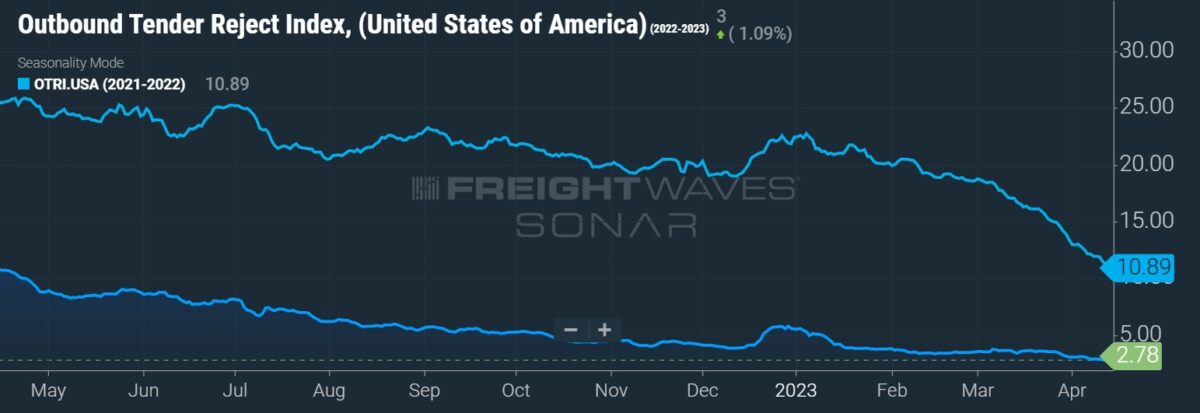Freight shipments fell in March alongside transportation costs, according to payment services provider Cass Information Systems.
The shipments component of the Cass Freight Index declined 1% from February, 4% lower year over year (y/y). The expenditures subindex, which measures the total costs associated with shipping freight inclusive of fuel, fell 1.5% sequentially and 12% y/y.
“Soft real retail sales trends and ongoing destocking remain the primary headwinds to freight volumes, and sharp import declines suggest this type of environment will persist for some time,” said ACT Research’s Tim Denoyer.
Assuming normal seasonality moving forward, Denoyer said shipments will be 1% to 3% lower y/y over the next few months.
| March 2023 | y/y | 2-year | m/m | m/m (SA) |
| Shipments | -4.0% | -3.4% | -1.0% | -3.8% |
| Expenditures | -12.0% | 17.2% | -1.5% | -2.8% |
| TL Linehaul Index | -9.6% | 3.2% | -0.6% | NM |
Truckload rates are expected to continue to fall, according to a report published by investment firm TD Cowen (NYSE: TD) and 3PL AFS Logistics. A predictive freight index showed per-mile TL rates will be down 13.1% y/y in the second quarter and just 6.6% higher than when the index started in January 2018.
As freight data continues to bobble along the bottom, industry analysts are showing concern that a material recovery in demand may not take shape in the second half, which was the consensus expectation heading into the year. However, shippers provided a bit of optimism around inventories in a recent Morgan Stanley (NYSE: MS) survey.
Of those polled, there was a 10-percentage-point increase in the number of respondents saying they would maintain current stock levels, suggesting shippers’ sustained efforts to curtail merchandise overhangs are working. There was also a decline in those saying that their inventories need to be reduced for the first time in six quarters. Overall, nearly 75% expect inventory levels to normalize this year.


Backing out the impact lower shipments had on the total amount spent on freight in the month, rates on an inferred basis were 8.3% lower y/y, according to Cass. Lower fuel prices were the primary reason for the decline in inferred rates but “there’s clearly also still market pressure on rates,” Denoyer said.
Cass’ TL Linehaul Index, which excludes fuel and accessorials, fell sequentially for the 10th straight month in March, down 0.6% from February and 9.6% lower y/y. The data set includes both spot and contract freight.
Denoyer noted that TL typically takes share from less-than-truckload and intermodal in loose freight markets. This modal mix shift has been captured by Cass’ index over the past year. However, that trend has reversed in recent weeks, suggesting “the trucking industry has passed peak looseness” and that “capacity growth has started to slow, and a rebalancing has begun.”
Data used in the Cass indexes is derived from freight bills paid by Cass (NASDAQ: CASS), a provider of payment management solutions. Cass processes $44 billion in freight payables annually on behalf of customers.
More FreightWaves articles by Todd Maiden
- Container lessor Triton to go private in $13.3B deal
- Truckload rates ‘tumbling’ in Q2, report says
- Morgan Stanley sees freight upcycle nearing










